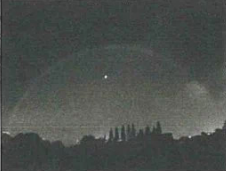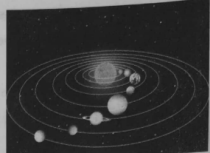
You might have seen beautiful rainbows in the sky before. They form when sunlight falls on water drops in the air. But in fact, moonlight can also create rainbows in the same way. They are called “moonbows”. They are similar to rainbows, but they are created by moonlight instead of direct sunlight.
Moonbows are rarer than rainbows. Different weather and astronomical (天文学的)conditions have to be just right for moonbows to be created.
The moon has to be very low in the sky-only 42 degrees from the horizon (地平线). The moon period has to be a full moon or nearly full. The sky must be very dark for a moonbow to be watched clearly-any bright light can obscure it. Water drops must appear in the air in the opposite direction of the moon.
Moonbows appear on the opposite side of the moon and usually look white to the human eye. This is because their colors are not bright enough to be noticed by the human eye. It is possible, however, to view the colors in a moonbow using long exposure (长时间曝光)photography.
Moonbows more often appear in some locations around the world. Most of these locations usually have waterfalls, which create thin fog in the air. Some of these locations are the Yosemite National Park in California and Cumberland Falls State Resort Park in Kentucky, US; Victoria Falls on the border of Zambia and Zimbabwe; and Waimea in Hawaii, US.
Moonbows do really happen. So at a certain time and a certain place, when a moonbow happens to appear, you can’t miss it if you’re right there.
【小题1】According to the first two paragraphs, moonbows are ________.| A.created by sunlight | B.much easier to find |
| C.seen during the day | D.more difficult to form |
| A.A half moon hangs high in the bright sky. |
| B.A full moon is 50 degrees from the horizon. |
| C.A nearly full moon hangs low in the dark sky. |
| D.Water drops are in the opposite direction of the sun. |
| A.cover | B.drop | C.connect | D.produce |
| A.Conditions of moonbows. | B.Background of moonbows. |
| C.Locations of moonbows. | D.Development of moonbows. |
Venus (金星) is close to Earth.
Scientists have been learning about Venus for a long time. First, they looked at Venus through telescopes (望远镜). But Venus is covered with thick clouds.
For a long time, scientists thought that Venus had water and plants. They thought Venus might have animals, too.
| A.Then scientists found a way to learn more about Venus. |
| B.It is the second planet from the Sun. |
| C.The scientists learned a lot from the probes. |
| D.But they didn’t know for sure. |
| E.Scientists could not see Venus well through the clouds. |
We look at the sun every day.
On September 2nd, 2021, China’s Fengyun-3E satellite took its first photos of the sun.
One of the satellite’s sides faces the sun all the time.
Clear pictures of the sun can help scientists study it more deeply. For example, scientists can better study solar storms (风暴). These may affect (影响) weather on Earth.
根据短文,从A~E中选出能填入空白处的最佳选项。
| A.It used China’s first solar space telescope (望远镜) to do the job. |
| B.By watching the sun closely, we can take actions to protect ourselves. |
| C.Big solar storms may also make our phones stop working. |
| D.But do you know what the sun really looks like? |
| E.It can watch the sun’s activity without stopping. |
组卷网是一个信息分享及获取的平台,不能确保所有知识产权权属清晰,如您发现相关试题侵犯您的合法权益,请联系组卷网



